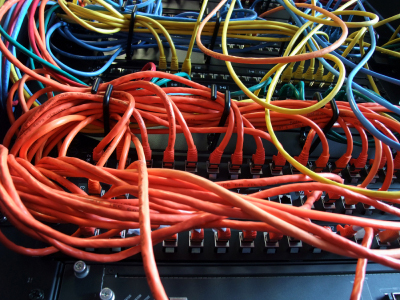The Raritan Blog
Home » Raritan Blog
DCD Dallas on December 11th - Limited Number of Complimentary Passes Available
Dorothy Ochs
November 30, 2012
Raritan has a limited number of free passes for end users only. Contact us to take advantage of this offer. And don’t forget to stop by our booth for your chance to win an iPad and see our smart rack. Raritan’s smart-rack management solution consisting of:
- A rack controller and/or intelligent rack PDUs with sophisticated controller boards which support power metering and control at various levels
- Environment sensors such as temperature, humidity, air pressure, and airflow
- Other sensors such as contact closure and webcam
- Electronic asset tracking
- KVM for remote management of devices
- Energy management and data center infrastructure management (DCIM) software
Hope you can join us in Dallas! For more information about DCD Dallas, visit http://www.datacenterdynamics.com/conferences/2012/dallas-2012.
Unique Data Center Energy Management Solutions
November 28, 2012

According to a recent New York Times article, U.S. Data Centers consumed 76 billion kilowatt-hours in 2010. At the Green Data Center Conference in Santa Clara, there was a great deal of discussion on data center energy waste. But there was more on just how far data center managers are willing to go to make their data centers more efficient without sacrificing performance. Raritan has several inventive solutions to achieve this.
Solutions to optimize comatose servers
One of the main issues data center managers want to solve is how to manage their servers so they’re not running when they’re not needed. It’s a knowledge and management issue. In fact, comatose servers are one of the largest wastes of energy in the data center. Kenneth Brill of the Uptime Institute estimates that 15% - 30% of data centers’ servers could be turned off.
Raritan’s Power IQ, when coupled with our intelligent Power Distribution Units (iPDUs), helps you identify under-utilized infrastructure so you can save energy. The solution gives an entirely new meaning to the phrase “knowledge is power.”
Over-provisioning of power and infrastructure
- 99.5% SLAs.
- Complaining end users who have come to expect an “always-on” readiness.
- Demanding industries like finance and gaming where transactions happen in milliseconds and nanoseconds.
In the face of end-user demand, try telling a data center they can’t over-provision.
Over-provisioning power supply to data centers is simply standard practice. Data center managers know it’s the only way to keep up with service level expectations and to manage spikes in traffic.
Or is it?
When data center managers have granular data down to the outlet level, and have the software to make sense of all that data, they’ll begin to see where energy capacity is stranded and can be better used.
What data center managers need is a tool set to visualize the data center from an asset standpoint - how much capacity any particular device is using in real-time. Such a solution would allow them centralized monitoring, email notifications, graceful OS shutdown, outlet control, powerful analytics of your costs, line capacities, carbon footprint and rack temperature.
Capacity vs. Consumption
As you probably know, most colocation facilities charge customers for energy by the capacity they provide rather than the real-time consumption per month or per year. Because of this, the customers say “Well, if I am paying for a certain capacity, then it’s up to me to utilize as much as possible so that I don’t leave any money on the table.”
Raritan has a solution for customers in this situation. We created power strips that will be rated for the maximum available rating allowable for each particular need. Meanwhile, most of the industry has chosen to stay under a certain rating to minimize the PDU cost. What it leaves the customer with is a less than optimal solution. Raritan’s solution gives data centers the maximum rating regardless of the capacity needed. It’s within ANSI guidelines and comes in at a reasonable price. Also, this eliminates the need to create more cabinets in the data center or in the colocation facility and saves a considerable amount of money and effort.
Large deployments of iPDUs
If your data center embraces all of this and suddenly decides to install hundreds, or even thousands of iPDUs, you could have a real mess of credentials, unique policies and alerts. Raritan came up with a simple way to help:
A USB Stick.
You provide the USB stick with a list of PDUs and power strips and their corresponding credentials and policies.
One of your techs goes to each PDU, plugs this USB stick into them and the PDU will read what’s in the stick and configure itself with the required credentials.
When an iPDU is configured correctly, we put a smiley face on the screen so you know it went well and it took the right credentials.
Further Reading
Bill Brill Interview - WallStreetAndTech.com
Energy Star Data Center Energy Efficiency Initiative
New York Times - Data Center Energy Waste
Raritan will be unveiling an industry-first DCIM solution at next week's Gartner Data Center Conference
Dorothy Ochs
November 27, 2012
We are inviting you to see our new solution. Stop by Raritan’s booth #711 to learn how to simplify and reduce the cost of instrumenting your data center for DCIM. Intelligent PDUs and environmental and electronic asset sensors now can be added to racks without investing the time and cost associated with running wired Ethernet connections.
We will also be showing how our DCIM solutions can help you monitor energy, capacity, assets, and the overall health of your data center.
Visit gartner.com/us/datacenter to register now with priority code DCSP5 and receive a special $300 discount.
We look forward to seeing you in Las Vegas!
Common Pain Points in Data Center Infrastructure Management
November 20, 2012
By - Khaled Nassoura, PE, General Manager, DCIM Software of Raritan
As we meet with companies around the world - from small, to midsize, to large enterprises - we’re struck by the similarities of the difficulties they share in managing their data centers.
If we had to pick one, over-arching description of the common problem, it’s this:

Knowing the physical, logical relationships that tie all their data center assets together as well as how these assets are tied to the infrastructure that supports them.
Here’s an example. Let’s say you would like to know the impact an infrastructure element such as a circuit breaker or a network switch port may have, upstream, on the servers that are connected to it. Furthermore, you’d like to know what applications are running on these servers and what departments or business units are being supported by these applications. These are the questions that become very difficult to answer “on the fly” when you have an urgent need to understand those dependency mappings.
Many of these data centers especially in the financial sector simply cannot afford to have any downtime. They must resolve any problems very quickly. This requires complete visibility into their systems and the infrastructure that supports their systems. For a data center manager, understanding the relationships between the assets and the infrastructure – dependency mapping – is extremely important.
A Dynamic View of Your Data Center’s Capacity
A very important topic in data centers today is capacity management and capacity planning.
Capacity planning is a simple as arithmetic. It is the total provisioned infrastructure minus the consumed resources and infrastructure. The total provisioned infrastructure in the data center is usually very static can be documented relatively easily by the architects and engineers who designed and built your data center. That’s the total size of your data center – how much power you have available; how many network switches and ports you have; how many power strips you have; how much power you have available to every rack; all of this is static information.
But data centers are never static
What’s very difficult to get a handle on is the number of resources that are in use at any point in time. That is a very dynamic set of information, and you can only get a handle on it if you have a system that can look at your data center from a holistic point of view and keep track of what goes in and out, what resources are in use, what’s connected and what’s disconnected.
So for data center managers to know the available data center capacity at any point in time, they must know the total provisioned infrastructure, which is relatively static, minus what’s in use at any point in time, which is very dynamic.
Without a DCIM solution, it’s impossible to get an immediate handle on these dynamic changes in the data center. Data center mangers don’t have the tools to easily track network and power connectivity. And if they don’t track the connectivity that means they don’t track those infrastructure resources that are in use at any point in time. Manual tools such as spreadsheets and Visio cannot keep track of this very dynamic set of information. Even data center management software tools that do not incorporate good connectivity management practices do not enable data center managers to accurately calculate their data centers’ capacity.
Raritan can help. Raritan’s DCIM solution is unlike any other and offers:
- Complete, all-in-one software solution
- Asset, connectivity, capacity, and change management
- Power, energy, and environment management
Click here to join our group on Linkedin.
Free passes available for end users - November 27th DCD Toronto
Dorothy Ochs
November 20, 2012
End users are invited to attend the upcoming DatacenterDynamics Toronto show on November 27th. Stop by our booth to see our latest solutions and enter a raffle drawing for a new iPad. Simply contact us if you would like a free pass. \
For more information, visit http://www.datacenterdynamics.com/conferences/2012/toronto-2012.
Subscribe
Upcoming Events
- Advancing Data Center Construction West 2024
- May 6 – 8 • Salt Lake City, UT
- Net Zero Data Center
- May 16 – 17 • Dallas, TX
- 7x24 Exchange Spring
- June 9th • JW Marriott Orlando Grande Lakes
Latest Raritan News
- Legrand Certifications and Process Controls Provide Confidence in Information Security for Network-Connected Devices in Data-Related Applications
- Posted on April 1, 2024
- Legrand Releases Version 4.0 of Raritan’s Industry-Leading Secure KVM Switches, Raising Bar for Secure Desktop Access
- Posted on July 31, 2023
- Legrand Revitalizes Data Center Sector with Two Revolutionary Intelligent Rack PDUs
- Posted on May 1, 2023
- Raritan Reveals The MasterConsole® Digital Dual KVM Switch
- Posted on February 18, 2021
- Legrand Data, Power and Control Division Announced as Finalist in Six Categories at DCS Awards 2020
- Posted on November 9, 2020